Card Duty, Part 2
Last week, I began my Magic 2015 card-by-card design stories . As I only made it to H, that means that this week is Part 2. Remember that, as part of this two-part column, I am discussing the fifteen outside-designer cards made for Magic 2015. I'll mention as I hit each card if it's one of the outside-designer cards.

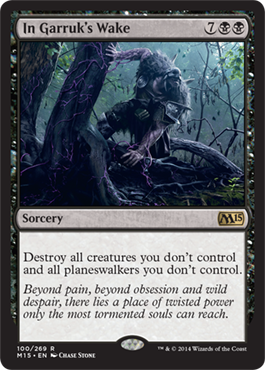
We wanted to make sure players were afraid of Garruk. Yes, we made Garruk, Apex Predator (see last week's article) but that wasn't enough. We wanted a spell that would make the opponent shake in his or her boots. Well, black is allowed to kill both creatures and Planeswalkers. What if we just turned that dial up to 11? What if Garruk killed all creatures and all Planeswalkers? How about just all of your opponent's creatures and Planeswalkers? You're smart enough to stay out of his way.

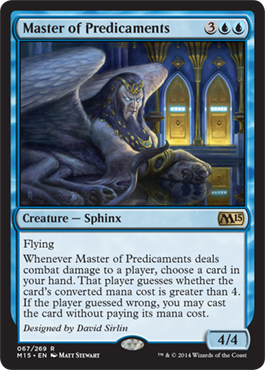
This is the eighth outside-designer card. It was designed by Dave Sirlin, designer of Super Street Fighter II HD Remix and Yomi. (Also of a cool new chess variant if you're in to that type of thing.) Dave's design is what we refer to as a bluffing card. A bluffing card is one where you have to make a decision, but its effectiveness is based on whether or not your opponent can successfully guess what you are about to do. As Dave Sirlin is famous for game balance, he does something very smart: he makes a weighted choice.
What do I mean by this? Well, the card allows you to play a spell for free from your hand. The opponent has to decide whether the spell costs 4 or less or 5 or more. If your opponent guesses correctly, he or she stops the spell. Now, a spell that costs 5 or more is going to be a stronger spell. So wouldn't your opponent err toward choosing 5 or more, to guarantee the bigger spell doesn't happen? Your opponent can, but then you get to cast a smaller spell if he or she doesn't guess that's what you're up to.
Also, an average deck has a lot more cheap spells than expensive ones, so the odds are that most of the spells will be smaller, meaning if your opponent chooses 4 or less, he or she is more likely to hit a larger number of spells in your hand. So why not just choose 4 or less, as much of the time it will hit all the spells in your hand? Your opponent can, but what happens if you have the bigger spell and choose to try cast it?
As you can see, Dave has set up a very dynamic situation that allows each player to weigh a number of different factors. It's not just a coin flip, and that's what makes this card so interesting.

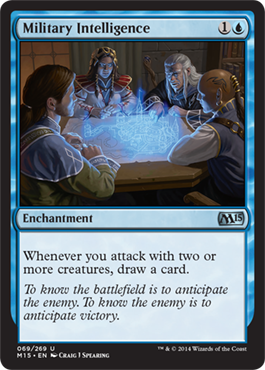
One of the fun ways to design a new card is to take a reward but tie it to a condition that is not normally associated with it. For example, blue is all about card drawing but is the color that least attacks with its creatures. Military Intelligence takes this contrast and builds a card out of it. Hey blue player, you want to draw a lot of cards? We know you do. So let's find a way to attack with a lot of creatures.
Designs like this are cool because they force players to think about decks from a new vantage point. I've talked a number of times before about how I try with each design to begin from a new starting point, so I'm forced to approach things from a direction I never have before. This allows me to discover things I might not otherwise have ever stumbled upon. I feel card design can often do this as well.


Nissa first appeared as the character on the cover of the original Duels of the Planeswalkers.

We knew from the moment we saw the image it was just a matter of time before Nissa got her own Planeswalker card. That card showed up in Zendikar.
On Nissa Revane, we tried something new. She referenced another card and, if you wanted to most effectively use her, you really needed to put some Nissa's Chosen cards into your deck. This ended up making her very niche. Yes, Nissa was strong in the Elf deck but had little use in any other deck. This led to Nissa not scoring so well in the godbook study. We knew, though, that the character was interesting and the response was more to her card than her character. (Although to be fair, the original version of Nissa, character-wise, was a bit elitist.)
As Magic 2015 was going to be the chance for us to make a new Planeswalker card, we wanted to make sure that she stayed true to her character but had a little more generally useful set of abilities. The design and development teams decided to play up her tie to the land and her ability to create nature elementals. This was done through animating lands into 4/4 Elementals.
As Nissa is coming back into the storyline, I'm happy we were able to make her a card that I hope should win her some new fans.

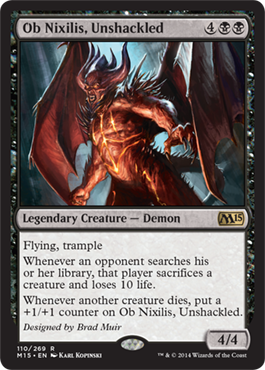
This is the ninth outside-designer card. It was designed by Brad Muir, a game designer at Double Fine Productions leading Massive Chalice, who was project lead on Iron Brigade. The story behind the design of this card is pretty interesting. Brad didn't set out to make Ob Nixilis (a former demon Planeswalker we met in Zendikar who lost his spark during the Mending). He just made an interesting Demon card. Then, when he turned it in, it became apparent the design would make a good Ob Nixilis. The design, like the original Ob Nixilis, plays into the theme that the misery of others makes him stronger. We talked with Brad and asked if it was okay to turn his design into a story character (which would obviously make it legendary) and Brad said yes.
Design-wise, the card does something cute: instead of preventing something, the card has it come with a devastating drawback. Hey, the opponent can search his or her library, but it's going to cost 10 life and a creature. (Ouch!) Also, the fact that the creature slowly grows over time meant that development could be a bit more aggressive in the costing, as you won't immediately have a giant flying trampler. The +1/+1 mechanic and trample also means that chumping Ob Nixilis is not a particularly effective counter measure.

One of the fun parts of doing an article where I wasn't at the meetings is that I get to try and guess how things came to be. For the Paragon cycle, I think I have a pretty good guess. Color lords (i.e., cards that boost all your creatures of a certain color) are popular, but we don't have a chance to do them all that often, because usually white is the color that tends to boost its own color. The design trick to bleeding effects like these is to make a cycle.
Boosting creatures is general enough that it's something we can let every color do now and again. By making it a cycle, we could create something players would like in a way that didn't imply that a certain color other than white was regularly supposed to be doing this. The design team made a tight cycle, meaning that all the creatures had the same cost and power/toughness (3C and 2/2) as well as granting them all the color-boosting ability. To separate them, each creature was then given a second ability—this time an activated one with a tap, to grant a keyword in flavor for the color. The keywords chosen were all ones that interacted with the power/toughness boost.

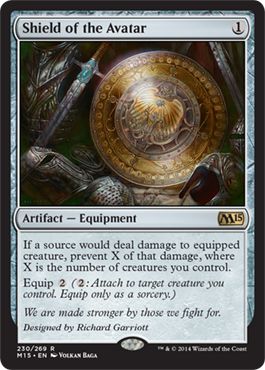
This is the tenth outside-designer card. It was designed by Richard Garriott, probably better known as "Lord British," the creator of the Ultima series. This design plays around with what in design we call the Keldon Warlord ability.
This ability showed up in Alpha on the red card Keldon Warlord. It was a creature whose power and toughness were equal to the number of creatures you had in play (okay, technically non-Wall creatures). We liked this ability. It was both popular with the players and had good game play, but we felt it was in the wrong color. We originally put it into green because, at the time, green was the "creature color" and was the color that could pump out the most small token creatures. Also, green was king of the variable creatures that grew over time, being the color of growth.
Eventually, we decided we wanted a clearer division between green and white and decided that green was going to go tall while white went wide. What that meant was that white was going to build an army out of a lot of small creatures while green would use its mana-ramping ability to get out fewer but much bigger creatures. This division, though, didn't make a clear decision as to which color was supposed to get the Keldon Warlord ability.
White was the color of the army and thus had more creatures so there was synergy, but green was the color of large variable creatures, of which this was a subset. The discussion was brought to a Card Crafting meeting and it got pretty heated, as there were strong camps on both sides. In the end, it was decided that white needed it more, so the ability got moved to white.
All of this is just preamble to Richard's design. Instead of using the ability offensively, as it is most often used, Richard decided to use it defensively, as a means to do a top-down shield. The bigger your army, the more protective this magical shield. I like how it takes an ability we've used many times but puts it in a different context, which helps sell the flavor of the card.

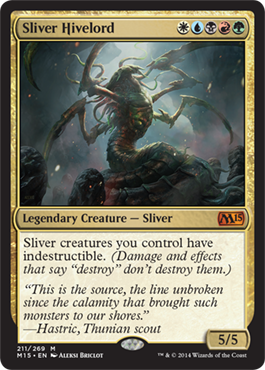
What was the number one complaint I got for Magic 2014? It was about the Slivers, but it might not be what you would've guessed. The number one complaint was "Why wasn't there a five-color legendary Sliver?"

Slivers first appeared in Tempest Block. That had Sliver Queen. They next appeared in Onslaught block. That had Sliver Overlord. Then they appeared in Time Spiral block. That had Sliver Legion. The Slivers had appeared three times before and, each time, the block got a legendary five-color Sliver. Where was the one in Magic 2014?
There were a number of reasons we didn't include it. Core sets don't normally do multicolor cards. Core sets don't normally do all that many legendary creatures. In the end, we realized we'd made a mistake. When enough of your audience expects something and you don't deliver it (assuming the reason isn't an issue of being harmful to the game), you've made a mistake. So, Sliver Hivelord was our attempt to right a wrong. The set also includes a cycle of Slivers to help give your Sliver decks one last little boost.
So, enjoy!

One of the things the core set has to always think about is its interaction with that year's Duels of the Planeswalkers (the more intro-level computer game made for game consoles, PCs, and tablets). The Soul cycle was playing into Duel's reliance on planes as settings for different parts of the game. What if the design team could make a cycle of creatures that could embody those six planes?
To do this meant tying each world to a color in the cycle. Originally, this cycle had only five cards and Shandalar (the basic home world of Duels) was left out, but when the team realized they could make New Phyrexia's Soul an artifact creature, Shandalar was back in play. Some connections were easy. Innistrad has always been a black-leaning plane, so making it the black part of the cycle was a gimme. So too was tying Zendikar to green. Of the three remaining colors, white was the clear choice for Theros (as the other main contender, green, was no longer a choice). Blue felt like a better tie to Ravnica, which left red with Shandalar, which, being the most basic, had the easiest time tying into whatever color it got.
The team then worked to find an ability for each Soul that matched the feel of the world while still fitting in the color's piece of the pie. The graveyard ability on each was to give them some extra splash and give them a second use if they ever got killed. The creature keyword was just done as one more thing to set the colors apart.
I was on neither the design nor the development team, but I do know this cycle went through many, many, many versions. It held a lot of weight, so I know Aaron Forsythe wanted to make sure the cards ended up as splashy and exciting as the cycle wanted them to be.

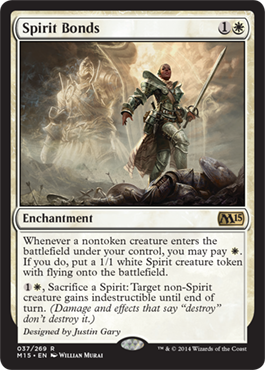
This is the eleventh outside-designer card. It was designed by Justin Gary, designer of Ascension: Chronicle of the Godslayer and SolForge. Justin is also well known for being a top pro player. He won a Pro Tour (Pro Tour Houston in 2002), a Grand Prix (GP Pittsburgh in 2003 as part of a team), US Nationals (in 1997), and a World Team Championship (in 2003). Justin has yet to be voted into the Pro Tour Hall of Fame but is always in the discussion. (I've voted for him numerous times and believe he has the stats to be voted in.) Justin is also the person I know best of the fifteen outside-designers and someone I've long considered a good friend.
In his design, Justin plays into another favorite area of mine—token making. And he does it in a very clever way. Each creature comes with its own spirit guide. Obviously, he didn't want the Spirits making their own Spirits, as they would create infinite token creatures and make the game a draw, so he only has non-token creatures making Spirits. Then, during the game, you have the ability to sacrifice the Spirit to save any non-Spirit creature.
I like that the flavor of the card is that each creature comes with its own protective spirit, but the card has the mechanic open enough to allow you to use all your Spirits to protect one creature if it's more important to you. Also, as a Johnny, I love all the shenanigans you can do with this card. There are a lot of fun activities one can participate in when you make a lot of creatures.

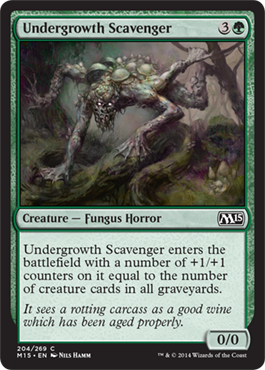
One of the games we designers play is to take classic old cards and figure out if we can clean them up a little. Undergrowth Scavenger is a great example. Do you know what cleaned-up classic card this is?
Click here once you have your guess.
Yes, it's Lhurgoyf. Calm down, Hans. It's okay. This is a kinder, gentler Lhurgoyf. Undergrowth Scavenger makes two changes.
First, it's power and toughness are */* rather than */*+1. Matching power and toughness is just easier to track, especially on a creature that always has different power/toughness from game to game. For those who are unaware, I hate */*+1 with a passion. It's just clunky for not enough gain.
The second big change, and this is really the big one, is that the creature checks once, when played, and locks in using +1/+1 counters. While it's cool that Lhurgoyf can grow bigger over time, the constant checking can get annoying. This version allows us to do this card at common, which is something we would never do with Lhurgoyf, meaning that it now gets to be a much bigger player in Limited. This, by the way, isn't to say we'll never make Lhurgoyf-style creatures again, but it allows us to have a

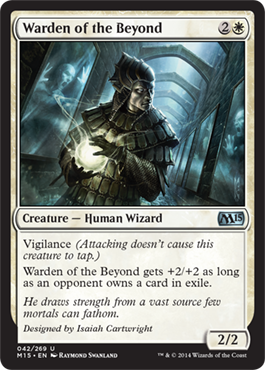
This is the twelfth outside-designer card. It was designed by Isaiah Cartwright, the lead designer for Guild Wars 2. This design is interesting because Isaiah chose to care about something we rarely care about—things being in exile. For those who assume I am going to have problems with this card because of my stance on cards interacting with the exile zone, you are incorrect. What I do not like is bringing cards back from the exile zone (except if they put it there—I'm fine with exile as a holding zone). Caring about things being in the exile zone is fair game and actually a pretty cool idea.
Warden of the Beyond asks a simple question: How can I get one of my opponent's cards in exile? (Clue: you might want to do it.) Jump through this hoop and you get a 4/4 creature with vigilance for only three mana. One of the things I like about this design is the simplicity. It cares about one thing and then gives you the reason to care. While it's fun to make a splashy card, I really enjoy the elegance of designs like this.

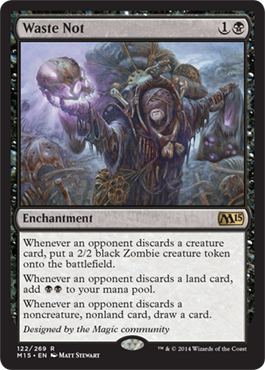
This is the thirteenth outside-designer cards. It was designed by you. Yes, you. Well, assuming you participated in the last "You Make the Card" promotion. Let me start by saying that I am always a bit skeptical with "You Make the Card," because I always imagine all the pitfalls a large group of people could have making a card in conjunction. But I believe Waste Not is a slam-dunk success.
The card has a clear purpose and it does its job in a clean and cool way. I also really like how it has enough variety built in that the card doesn't get boring, because it's always pushing you in different directions. Also, the flavor from the top-level card concept to the art to the mechanical execution is beautiful. It really is a lovely design. Good work, you.

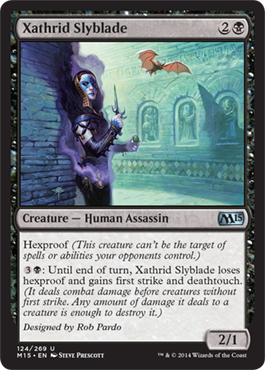
This is the fourteenth outside-designer card. It was designed by Rob Pardo, chief creative officer at Blizzard and lead designer of World of Warcraft. This card both drips with flavor and solves an ongoing problem we've been having. That problem is hexproof. The point of hexproof is to make cards resistant to magic, such that it's hard to kill them with spells, thus forcing you to fight them in combat. The problem, though, is that hexproof can be a bit frustrating.
Xathrid Slyblade solves this through cool flavor. The Xathrid Slyblade is an assassin. When she sticks to the shadows she cannot be seen and thus cannot be targeted, but when she strikes, she makes herself vulnerable. Why would she strike, then? Because by coming out of the shadows she can kill her prey with first strike and deathtouch, a combination so potent that we very rarely put them both on the same creature. The flavor was so good, though, that this seemed like a wonderful card to finally put these two abilities together.

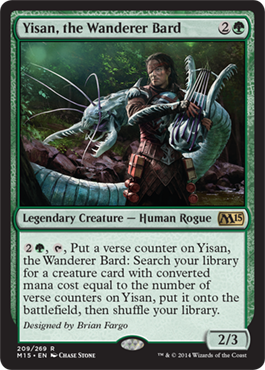
This is the fifteenth and final outside-designer card. It was designed by Brian Fargo, founder and CEO of inXile Entertainment, director of Bard's Tale and Wasteland and executive producer of Fallout. As I was not involved in Magic 2015, I can only guess at the evolution of this design. My best guess was Brian was making a top-down bard. Magic has had a few bards in its day, but none that have ever been all that splashy. Yisan is trying to change that.
Yisan plays his tunes and, as he builds up his repertoire, he is able to summon bigger and bigger creatures. I'm not sure if Brian made this legendary or if that was done in development. The design definitely leads to a cool story character. I enjoy the choice to have him get a creature each time he activates the ability rather than just building up to one summoning; it makes for a neat deck-building challenge, as the deck needs a wide range of mana costs so you can always get something. Note that it does not say "equal to or less." Each search is for an exact converted mana cost. This is a good example of how giving the audience a little less flexibility leads to a more fun card. Game-playing is all about overcoming challenges, so designers can't be afraid of making challenges through the card designs themselves.
Time to Catch Some Zs
Whew, I managed to make it all the way through the alphabet (which is a good thing, because next week is a theme week). As always, I would love to hear your feedback on today's article. You can email me, respond in the thread to this article, or contact me through any of my social media (Twitter, Tumblr, Google+, and Instagram).
Join me next week when I'll have a number of creatures on tap.
Until then, may you dream of one day getting your own Magic design into print.
Drive to Work #138—Playtesting
My first podcast talks all about what goes into playtesting during design (and a little bit during development).
Drive to Work #139—Rise of the Eldrazi, Part 4
My second podcast is the fourth in a five-part series on the design of the third set in the Zendikar block, Rise of the Eldrazi.

